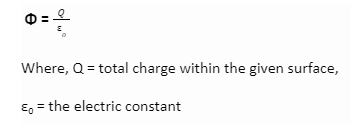The enclosed electric charge is perfectly proportionate to the net flow of an electric field on a closed surface, according to Gauss’s law. It is one of the four equations in Maxwell’s electromagnetic laws. It was first presented in 1835 by Carl Friedrich Gauss. Gauss’s Law is used to make calculating the electric field much easier. We can apply the law before learning more about the applications. We need to pick a Gaussian surface that makes examining the electric field simple. It’s important to realise that the Gaussian surface does not necessarily have to match the actual surface. Gauss Law can be used to obtain the electric field due to an infinitely long straight wire, uniformly charged infinite plane sheet, and thin spherical shell.
What is the Gauss Law?
The total flux related to a closed surface is equal to 1/ε0 times the charge encompassed by the closed surface, according to the Gauss Law. The charge confined divided by the permittivity equals the total electric flux out of a closed surface. The electric flux through an area is calculated by multiplying the electric field by the surface area reflected in a plane perpendicular to the field. Gauss’s Law is a common principle that can be applied to any closed surface. It is a useful tool since it allows you to estimate how much confined charge there is by projecting the field on a surface outside of the charge distribution. It aims to simplify the estimation of the electric field by using geometries with appropriate symmetry.
In association with Gauss’s Law, the theory of electric flux is useful. The electric flux throughout a planar area is calculated by multiplying the electric field by the area component perpendicular to the field. If an area is not planar, the flux must be evaluated using an area integral because the angle will be changing all the time.
The Gauss Law formula is expressed by –

The Applications of Gauss’s Theorem
Gauss’s Law can be applied to address complex electrostatic issues involving unique symmetry such as cylindrical, spherical, or planar symmetry. It also aids in the computation of the electrical field, which is highly complicated, and requires a great deal of integration. The Gauss Law can also be used to evaluate the electrical field straightforwardly.
The following are some of the most important applications of Gauss Law:
- To obtain the electric field due to an infinitely long straight wire:
Consider a wire that is infinitely long and has a linear load density of λ and a length of L. We suppose that the Gaussian cylindrical surface is due to wire symmetry in which to calculate the electrical field. The flow through the end of the cylindrical surface will be zero since the electrical field E is radial in direction and the electrical field and the area vector are perpendicular to each. The curved Gaussian surface will be the source of electric flux. The magnitude of the electric field will be constant because it is perpendicular to each point of the curved surface.
- If the linear charge density is positive, the electric field will be radially outward; if the linear charge density is negative, the electric field will be radially inward.
- Only the confined charge within the Gaussian surface was examined.
- The assumption that the wire is infinitely long is critical because otherwise, the electric field would not be perpendicular to the curved cylindrical Gaussian surface and are instead at an angle to it.
- To obtain field due to uniformly charged infinite plane sheet:
Consider a section of a thin, non-conducting, infinite flat sheet of charge with a constant charge density σ on the surface. Let’s say we are looking for the intensity of an electric field E at a point p1 near the sheet and r in front of it. To evaluate the field at p1, we identify a position on the opposite side of the sheet, p2, that is equidistant from the infinite charge sheet. Now draw a tiny closed Gaussian cylinder with round ends parallel to the sheet and going between p1 and p2. Assume that the flat ends of p1 and P2 have the same dS area. The cylinder is connected to a closed surface with flat ends, allowing Gauss’s Law to be applied.
For a positive charge sheet, the magnitude of electric field E is equal at all points of an infinite plane sheet of charge on both sides end caps and along the outward drawn normal due to symmetry.
- If the surface charge density is positive, the electric field is directed away from the infinite sheet; if the surface charge density is negative, the electric field is directed towards the infinite sheet.
- The infinite sheet’s electric field is independent of its position.
- To obtain field due to uniformly charged thin spherical shell:
Suppose the radius as “R” and the thin spherical shell of the density of the surface charge. The shell displays spherical symmetry, as can be seen by looking at it. The electric field generated by the spherical shell can be measured in the following ways:
- Electric field inside the spherical shell
- Electric field outside the spherical shell
- Since there is no confined charge inside the spherical shell, there is no electric field.
Conclusion
Gauss’s Law can be assigned to address complex electrostatic problems with unusual symmetry, such as planar, cylindrical, or spherical. In other conditions, the calculation of the electric field is also moderately difficult and requires a lot of integration. Gauss’s Law can be used to evaluate electric fields straightforwardly. We use Gauss’s Law to allot a Gaussian surface that makes evaluating the electric field simply and makes tasks easier by pertaining to symmetry. In addition, the Gaussian surface does not have to be parallel to a real surface; it might be inside or outside the Gaussian surface.
 Profile
Profile Settings
Settings Refer your friends
Refer your friends Sign out
Sign out






